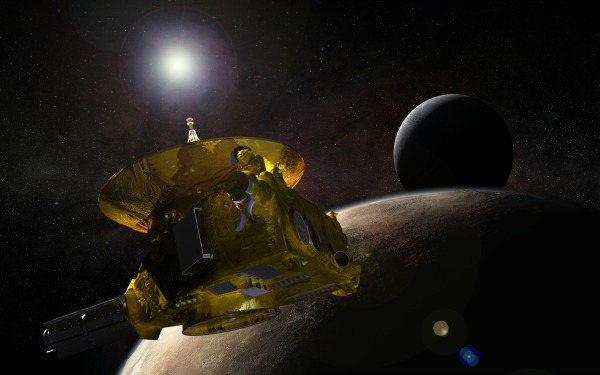

Finally. The day is here. Today, for the first time in the history of human-kind, we will soar past Pluto, and its system of moons. It has been nearly 9 and a half years. If you are keeping track, that’s 3,463 days or 8,3112 hours. In short, it has been a long, long wait.
For the last decade, this tiny spacecraft has been making its way across our solar system, heading towards the icy edges of our Sun’s sphere of influence, and it will finally reach its destination today (July 14th, 2015) at 7:50 am EST (1:50 pm CEST). However, unfortunately, the event won’t be all glitz and glam, nor will there be a bold Eureka! moment.
We still have a bit of waiting to do.
This is because Pluto is rather far away from our own Pale Blue Dot. It wanders through the cosmos some 4.67 billion miles (7.5 billion km) from Earth. As a result, it takes quite some time to communicate with the craft. In fact, it takes nearly four-and-a-half hours for communication to travel from our planet to New Horizons. Then it takes another four-and-a-half hours for New Horizons’ signals to travel back to us. This means that, after the craft’s encounter with the dwarf planet, it will take over a year for the onboard computer to transmit all the scientific data back to Earth.
But fear not, you won’t have to wait that long for photos. The first close-up images of Pluto and Charon are expected to be available tomorrow (15 July 2015). Scientists have high hopes for these images, as they should allow us to see the small world like never before. This will be a fantastic accomplishment because, as you can see, the best photos of Pluto from Hubble leave a little something to be desired…
[twentytwenty]


[/twentytwenty]
The above compares the latest image of Pluto to old Hubble shots (future images will put both to shame). But how can this be? Hubble is able to see stars that are hundreds of thousands of light years away. Why can’t it see an object in our solar system?
Well, it all comes down to light. Stars, as we all know, give off a lot of light. Planets, asteroids, and moons, on the other hand, are rather dark. And since Pluto is so far from the sun, it reflects very little light, which means that there is little for Hubble to capture.
But everything is about to change.
At its closest approach, New Horizons will be just 7,700 miles (12,500 kilometers) from Pluto. That may seem like a rather far distance; however, keep in mind that space is big. For example, at its closest, the moon is still some 225,600 miles (363,100 kilometers) away. So although it might seem like New Horizons is rather distant, in cosmic terms, it will be just next door to Pluto. And the images that it’s already returned have been spectacular.

But of course, New Horizons will be doing a lot more than just taking pretty photos. NASA has a host of experiments that they are conducting during this flyby, and they will be collecting information on the surface temperature, volume, density, and mass, just for starters. They will also collect images across the electromagnetic spectrum, as New Horizons carries with it the UV spectrometer Alice and the LORRI and Ralph high-resolution camera systems.
That said, New Horizons will have to work quick, and it better be up to par, because we won’t get a second shot. Since it is moving so unbelievably fast, roughly 31,000 miles (50,000 km) per hour, it won’t be possible for the craft to enter orbit (which is precisely why it is just flying by and continuing on into the Kuiper Belt). Fortunately, scientists have prepped for this time and time again, they’ve already returned an amazing amount of data, and the craft seems to be operating as expected. So everything seems to be on the up-and-up.
If you want to follow New Horizons as it journeys past Pluto (you can’t watch it live because of the communication delay), you can head to DSN Now. This legend shows you the various connections between our spacecrafts and Earth, so you can watch the data roll in as it comes. You can also watch the NASA coverage and celebrations here.
Don’t want to get up too early? You don’t need to. The first communications post-flyby are scheduled to arrive at 9:07 pm EST (3:07 am CEST) on July 14.